Engwe M20 E-Bike Review 2024
Full Suspension Cafe Racer For Throttle Fun Without The Pedaling
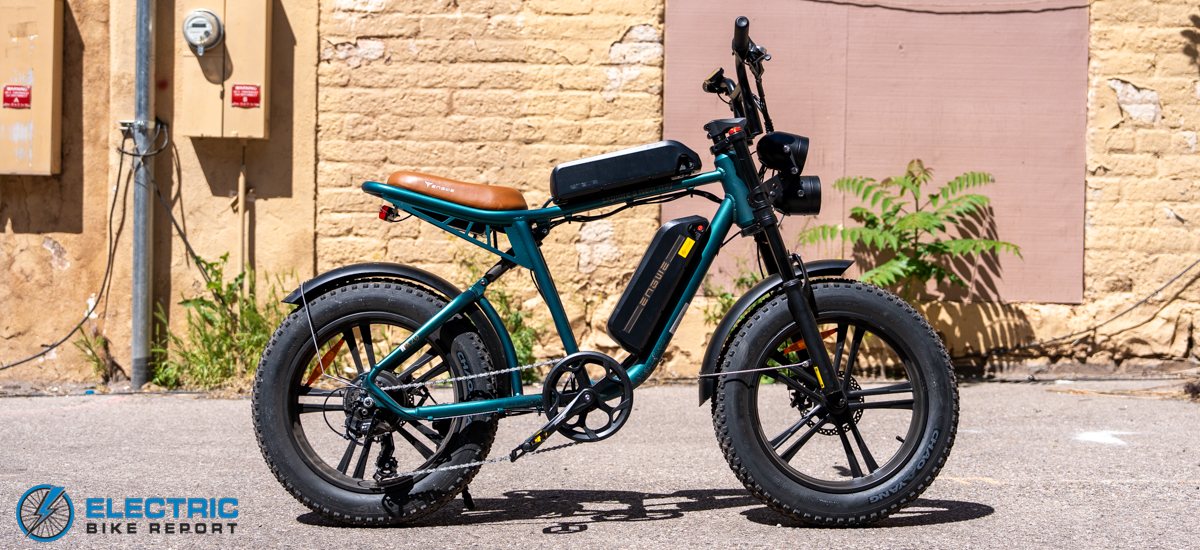
The M20 is a Class 3 e-bike, with motor power from the throttle up to 20 mph, and motor power through the pedal assist up to 25 mph. This e-bike’s low-sitting, sporty design makes a great handling bike for riders of all levels. When you first hop on this bike and grab the handlebar, you’ll likely yearn for adventure. This bike’s design and feel will invite you to go where you haven’t gone before.
Until recently, full suspension e-bikes resided in the $3000-plus range, leaving many new riders to opt for hardtail e-bikes instead. But Engwe came up with the right recipe for suspension and performance, and offered this bike for a price that’s considerably lower than most of its competitors. So, if you’re interested in this kind of sporty BMX-style e-bike, then you’ll want to keep reading about our review and performance tests on this bike.
 Pros
Pros- Unique full suspension design will surely satisfy riders looking for a much smoother ride over rough terrain.
- 750W motor delivers on top end power, making this a good ride on city streets.
- Great handling makes it an easy bike to maneuver, and helps new riders gain more confidence.
- Mag wheels instead of spokes allow this bike to handle up to 400 lbs of rider and cargo, and withstand harder bumps.
- Powerful dual headlight system will give you more reasons to ride past sundown.
- Optional 2nd battery can boost your total range to 70 miles.
- Riders who want an e-bike that’s like the Super 73 R-series bikes for a lot less money will want to take a second look at this bike.
 Cons
Cons- Stationary saddle and short frame height makes pedaling awkward for riders taller than 5’5”. Throttle users won’t have issues though
- A fast bike like this would benefit from hydraulic brakes with larger rotors..
- Motor: 750W, Class 3
- Battery : 13Ah / 624Wh
- Display: Mono-color LCD, reads total & trip miles and time, battery output & level & more
- Headlight: Dual LED
- Taillights: Single LED
- Pedal Assist: PAS levels 1 – 5
- Range: Up to 60 miles
- Throttle:right hand full grip throttle
- App:None
- Claimed weight: 65 lb (30 kg)
- Max weight capacity: 265 lbs (120 kg)
- Brakes: mechanical disc, 160mm rotors
- Fork: Partner 916-110 air fork, 100mm travel, w/ compression adjustment
- Rear Shock: HLT-100 air shock, 125mm travel
- Frame: 6061 aluminum alloy
- Drivetrain: Shimano Tourney 7-speed, 14-28T cassette
- Handlebar: 27” (685mm) width, 7” (179mm) rise
- Stem: 3.375” (86mm) length; 1.25” (31.8mm) diameter
- Tires: 20” x 4” Chao Yang W105001 100-406 all-terrain knobbies
- Fenders: front and rear
- Levers: Wuxing aluminum alloy
- Grips: rubber grips
- Saddle: non-adjustable
- Kickstand: chainstay mounted
E- Bike Overview: Engwe M20
Affordable e-bikes often involve using affordable parts. The Partner suspension fork and HLT rear shock are from lesser-known companies, who are trying to earn a respectable place in the industry, and are priced lower than the big name brands.
The Partner air fork gives 100mm of wheel travel and has a compression adjuster for rebound, but no lockout. Lockouts aren’t needed as much on bike’s with 20-inch wheels, anyway, and besides, this bike relies more on power from the motor than the pedaler.
The HLT shock absorber mounts on the low end to a chainstay that’s been converted as a swingarm, and pivots on 1.25” bearing. The shock is not adjustable, but considering its size and frame, not much difference can be had with an adjustable one.
Boosting this bike’s sporty appeal are the 20-inch all-terrain tires, BMX-style handlebar, motorcycle-style saddle, and its powerful 750-watt motor. We don’t have specific information about the motor, and who built it, so we wrote this off as another way of keeping the price down on this bike. Same thing with the display unit, which is usually built and fitted with the motor.
Helping expand this bike’s range, it comes set up and ready for an extra battery, which we recommend you get. It weighs 65 lbs with a single battery, and we found the additional weight from a second battery didn’t make a big difference. The non-adjustable seat did make a difference, however, as taller riders on our team were less comfortable pedaling this bike around.
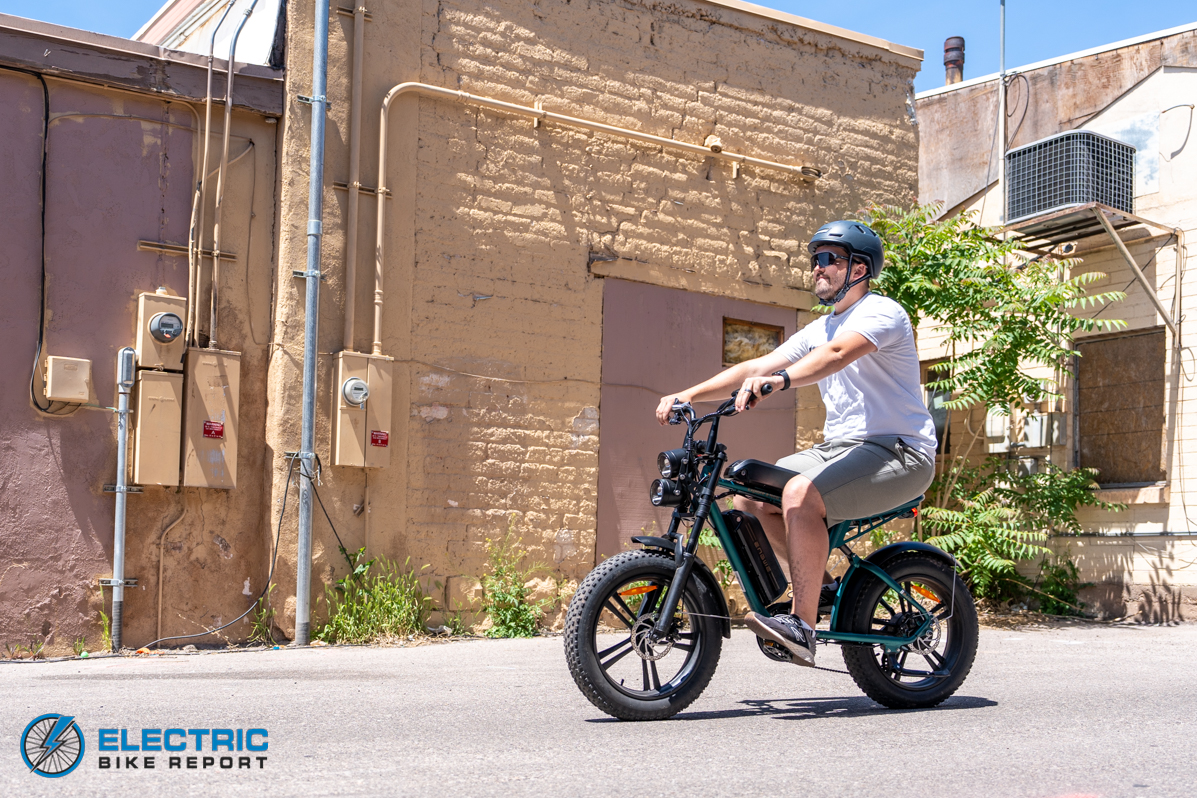
Cafe Racer vibes abound as you hit the streets on the Engwe M20

750W motor throttles up to 25 mph without pedaling

Mono-shock rear suspension provides a super smooth off-road experience.
Engwe’s engineers were thinking outside the box when they created this e-bike, and this challenges makers of similarly designed bikes, like the Super 73 R-series, to come up with new ideas that will get more butts on more seats of bikes like this. Considering the features this bike has, now it’s time to take a closer look at how it performed in our riding tests.
Circuit Speed Test: Engwe M20
Our first performance test is designed to show us how well the bike’s motor engages with the rider’s pedaling. We call this the Circuit Test because we use a course of designated streets to recreate real world riding conditions. The test results give us a speed profile for the bike and it is there that we can see the motor’s strengths and weaknesses.
As you can see in the chart above, the M20’s motor cranks out balanced chunks of speed, about 2 mph apart, at each of the pedal assist (PAS) levels. The motor’s engagement and disengagements were consistent, which is what you want with an e-bike motor. When you can predict when the motor will engage and disengage, you’re more likely to have a safer ride.
When riding on bike paths, you probably won’t need to go higher than PAS 3 to avoid exceeding the legal speed limit. That’s good because you’ll conserve more battery power and you’ll be able to ride longer. PAS 4 and PAS 5 will take you to speeds that are more appropriate for riding on the street.
One issue we would like to see Engwe address is the ghost pedaling at top speed. Ghost pedalig is when your bike is going too fast for your pedaling to have any real effect. You’ve probably experienced this before when pedaling a regular bike downhill. The M20 uses a 14-28T cassette that is geared too low for top speed pedaling. That means when you’re riding at top speed, the only role your pedaling plays is keeping the PAS activated to continue motor output.
So, we here at EBR challenge Engwe to address this. Perhaps they could replace the 14-28T cassette with an 11-28T cassette. Switching to a smaller cog for 7th gear will definitely reduce if not replace the ghost pedaling. Also, changing to a larger chainring, like a 52T instead of the current 46T one, would help.
Also, the motor’s torque output is pretty low at the bottom end, when you’re starting from a stop or slow speed. This bike uses a cadence sensor instead of a torque sensor, which means it’s only counting how many times the pedal goes around, rather than detecting how hard you’re pedaling. Therefore, we challenge Engwe to make this motor respond better at the lower power range. They could install a torque sensor, which would increase the bike’s cost. The other option is to re-calibrate the cadence sensor for riders who want better low end output. If you’re buying this bike to mostly ride in the dirt, this is especially important for you.

Pedaling is a bit cramped for taller riders, but the bike is fun to just throttle around.
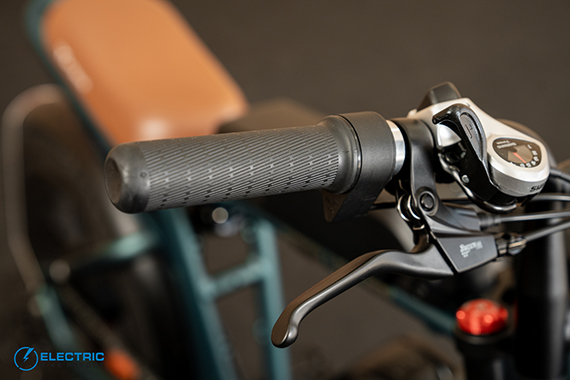
Motorcycle riders will love the full grip throttle; be sure to shut off the motor when lifting this bike onto a bike rack, or when parking.
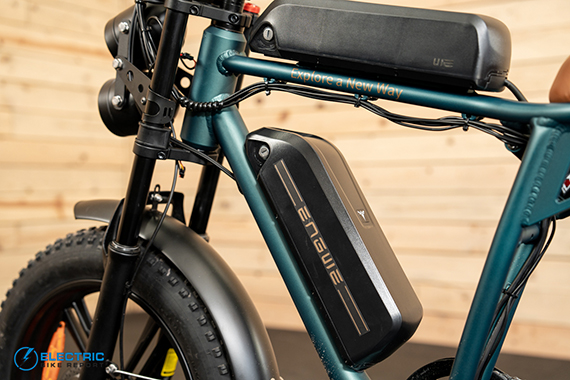
Dual battery configuration means longer ride times.
Range Test & Battery Performance: Engwe M20
Using one battery for the minimum PAS Range test, the M20 maxed out at 36.77 miles, in 2:54 and an average speed of 12.1 mph. If running both batteries, roughly doubling the mileage seems about fair for expectations.
On the maximum PAS Range test, I DID ride this bike with two batteries (the second battery arrived after we started testing this bike) and I went as far as 37.16 miles. This implies the M20 would go less than 20 miles on one battery. That’s a so-so result, as other similar bikes, with same size motor and battery, went up to 30 miles on PAS 5.
But we’re optimistic we’ll see improvement on this. After all, Engwe produced a uniquely designed e-bike. With these kinds of situations there are always snags in design that eventually get worked out. And I’ll bet that the Engwe team is working on this and will show better results when we test the newer version of this bike, after it comes out.
In the meantime, there are other ways to maximize range and energy efficiency, including adjusting your riding style, and doing more active pedaling. This is also a big reason why we think you should get the second battery if you buy this bike and plan on going fast – we would.
Hill Climb Test: Engwe M20
We designed our hill climb test to help us discover how much raw power an e-bike motor can produce for its rider. Our test hill, Southwest Utah’s notorious Hell Hole Trail, is probably longer and steeper than most hills faced by average commuters. But the hill test really helps answer the question about an e-bike’s climbing ability.
In the throttle-only portion of the Hill Test, the M20 reached the top in 1:35, and an average speed of 11.4 mph. In the Maximum PAS Hill Test, using PAS 5, the M20 reached the top in 1:31, with an average speed of 11.9 mph. In the throttle-only test, the bike is really relying on everything the motor can produce. It’s not uncommon for a bike to fail on the throttle-only test, but succeed on the max PAS test.
We were happy to see the M20 reach the top on both of our tests. Not all e-bikes make it to the top. Earlier, I mentioned how this bike has a lot of top-end power, helping it reach speeds upwards to 25 mph. That played a key role in both tests.
There is a bit of irony with these results, though, in that the maximum PAS time and average speed was just a tad bit quicker than the throttle-only result. Usually, the differences are greater between the two. One thing we can likely deduce is that the motor used considerably more battery power on the throttle-only test than on the maximum PAS test. But all in all, the important takeaway from these tests is that the Engwe M20 will likely get you to the top of most hills you’ll face, especially when you’re pedaling.

You’ll go pretty far and get there quickly on the M20
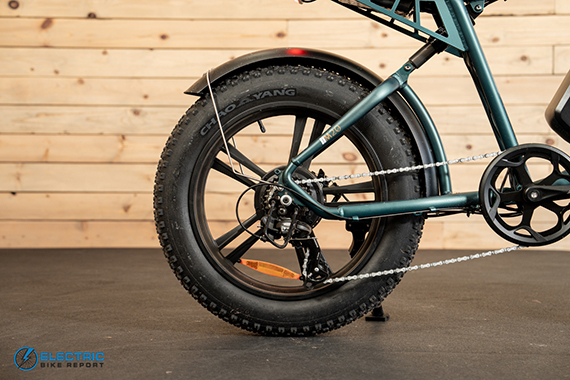
Mag wheels fit the look and you’ll never have to worry about knocking spokes out of true

Little features like brake lights help you feel safer when out on the roads
Safety and Brake Test: Engwe M20
The average stopping distance for the M20 was 24-feet, 5 inches, which was a little longer than the similar e-bikes with hydraulic brakes. We understand why Engwe went with mechanical brakes – they work decently, are easy to fix and maintain, and the parts are cheaper than hydraulic brakes.
Fortunately, with the money you’re saving on the price of the M20, it would be fairly easy to buy and install a good set of hydraulic brakes. We didn’t find anything wrong with the mechanical brakes, but this is a faster e-bike, and faster e-bikes deserve stronger brakes.
Ride Comfort & Handling, Cockpit, and More: Engwe M20
Riding comfort on the Engwe M20 is directly tied to rider height. That’s because the seat cannot be adjusted in height. Riders taller than about 5’5” are going to feel pain in their hips after they pedal this bike for a while. That’s because their knees are rising higher than they should when pedaling. When riders are professionally fitted with their bike, they are trained to make sure their knees don’t get closer than a 30-degree angle from their hips. This type of bike is typically used for heavy throttle purposes, but call us purists, we wouldn’t mind better pedaling options.
Therefore, we here at Electric Bike Report challenge Engwe’s smart team of engineers to come up with a larger frame design option that addresses this. There are a lot of 5’6” to 6’1” riders who would buy this bike in a second if they could raise the seat and have a better pedaling experience.
Other than that, the overall riding experience was pretty comfortable. Our team of riders all likes the seat’s padding. Two of us didn’t like how the seat was angled downward. And all of us agreed that the seat needs to be adjustable.
We also liked the rubber grips and the BMX-style riser handlebar. The Shimano Tourney 7-speed shifter worked okay, but the top lever used for downshifting is not easy to activate when sport riding. That’s why we recommend Engwe to replace that shifter with a below-bar trigger shifter, like Shimano’s Rapid Fire trigger shifter. This would make gear changes a lot easier, and the ride a whole lot funner.

The seat isn’t adjustable, but it is fairly comfortable.
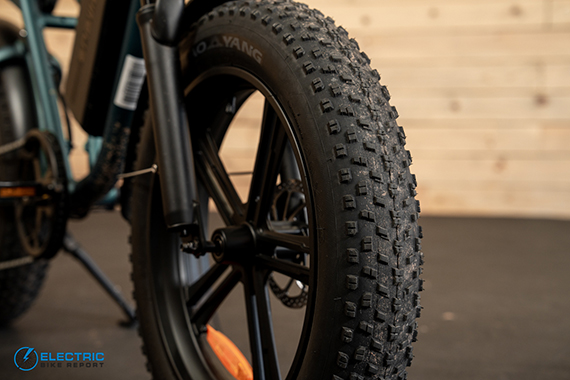
Chunkier tread on the tires allows for some terrain versatility

You’ll be plenty visible with the dual headlight display

The braking performance is just okay. Upgrades to larger rotors and/or hydraulic brakes would be nice
Summary / Where to Buy: Engwe M20
We hope this bike can introduce more riders to the benefits of having a full suspension e-bike. We can all agree that the key factor limiting growth with this style of e-bike has been the cost. Finding an affordable way to offer this design will likely help boost consumer interest. We will know the certainty of this if we start seeing more e-bike companies introducing their own low cost full suspension e-bikes. We saw a similar change occur in the motorcycle market of the late 1950s and early 1960s, when more brands started releasing models replacing the rigid rear suspension with rear shocks. So we could see that happen with e-bikes.
Seeing as how Engwe is a relatively new company, we hope that their unique approach to designing and building this bike with such a wallet-friendly price point will win them many fans around the e-bike world. In the meantime, we hope they give serious consideration to some of our suggested improvements and we look forward to reviewing, and sharing with you all, the latest features on one of their other models. Until then, we will continue riding the M20 and we’ll see how this bike lasts.
Engwe e-bikes are sold online and delivered directly to the consumer. Engwe e-bikes are shipped free of charge directly to customers in the contiguous states of the US (the lower 48 states). For current pricing, please click the link above.
Happy Riding! Make sure to let us know if you have any questions down in our comments section or if you think we left anything out in this review of the Engwe M20.





Too small and slow up the hill!
I’m 5’9” with a 30” inseam. Totally comfortable pedaling. I did upgrade mine to a 52t chain ring. New crank set and chainring plus crank puller toolset for under $60 on Amazon.
A cafe style bike at this price allows for upgrades that can make this model go from a good bike to a great bike. I was able to get plug and play hydraulic brakes for this model for $70..
Would it have been nice to see these features on the bike already? Absolutely! Just not for this price range.